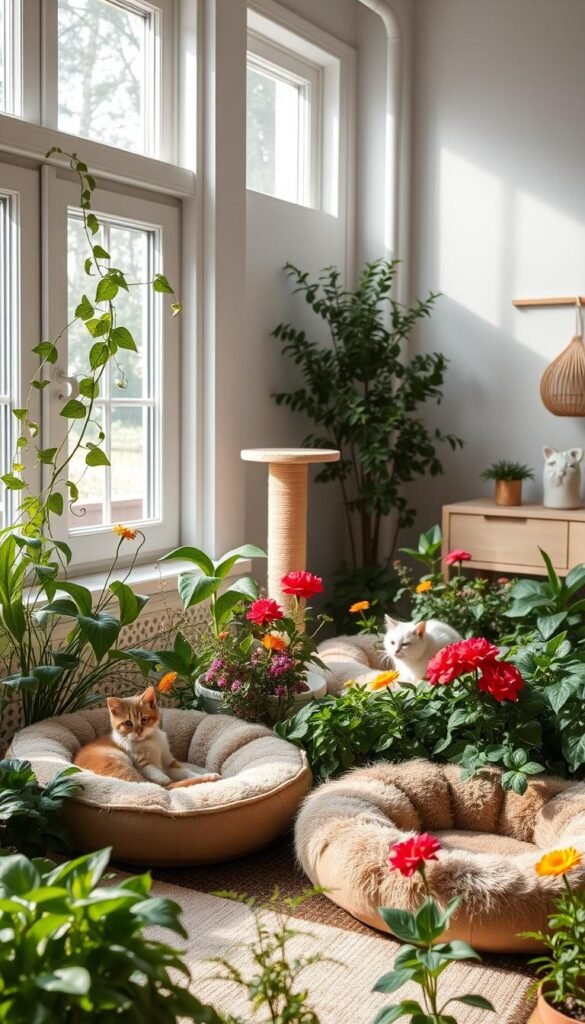Did you know your leafy decor could secretly harm your curious companion? Many popular houseplants contain toxins that pose serious risks to animals, as noted by veterinarian Judy Morgan and horticulturist Paris Lalicata. Even cautious cats occasionally sample greenery, making every plant choice matter.
The right foliage can transform your living area into a vibrant sanctuary that benefits everyone. Experts like those at the ASPCA emphasize avoiding species linked to tremors, seizures, or digestive issues. Their updated toxicity database helps owners navigate this hidden danger.
This guide simplifies blending botanical beauty with animal safety. You’ll learn which species thrive in homes while protecting playful paws. Discover how to design arrangements that satisfy your plant passion and your pet’s natural instincts.
We’ll share professional tips for cultivating worry-free greenery that sparks joy for both you and your whiskered roommate. From soil selection to strategic placement, every detail contributes to a harmonious shared space.
Transforming Your Home with a Green, Cat-Friendly Oasis
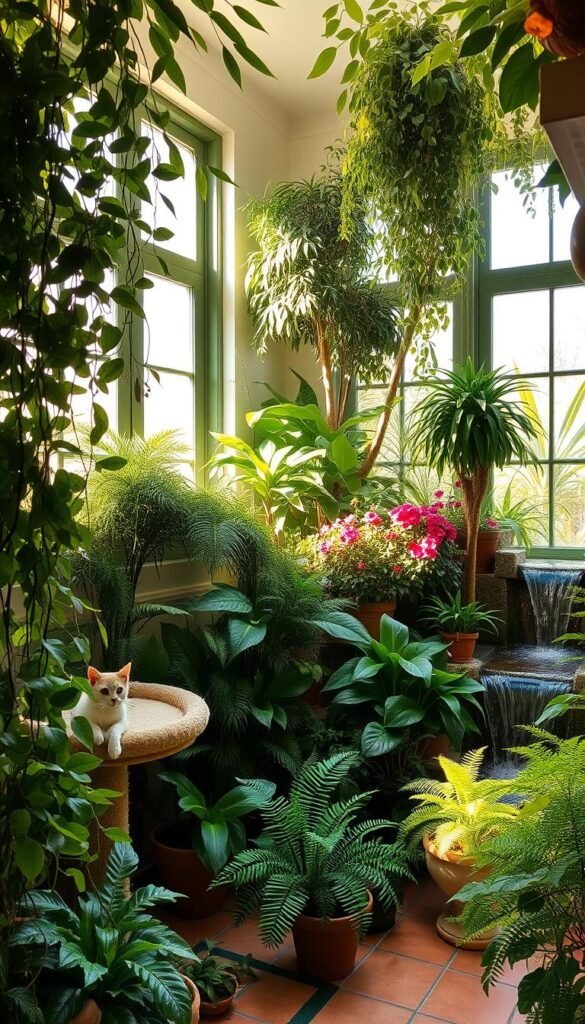
Creating a vibrant living space that both you and your feline friend adore is easier than you think. Greenery boosts air quality by filtering toxins, while adding natural beauty to rooms. Studies show houseplants reduce stress levels, making your environment calmer for everyone—paws included.
Choose leafy companions like spider plants or ponytail palms for visual impact without risks. These species thrive in indirect light and tolerate occasional nibbles. “The right foliage turns spaces into shared sanctuaries,” notes one urban gardener. Rotate pots to sunny spots to keep growth lush and engaging for curious companions.
Strategic placement matters. Elevate delicate varieties on shelves or use hanging planters to protect them from playful paws. Cluster sturdy, non-toxic options in floor-level corners where whiskered explorers can investigate safely. This approach balances aesthetics with practicality.
Your living area becomes a dynamic ecosystem where nature and pets coexist. Watching your furry roommate bat at safe leaves or nap beneath broad fronds adds joy to daily life. With smart selections, you craft spaces that nourish both plant passion and animal well-being.
Why Pet-Friendly Plants Matter for Your Furry Friends?
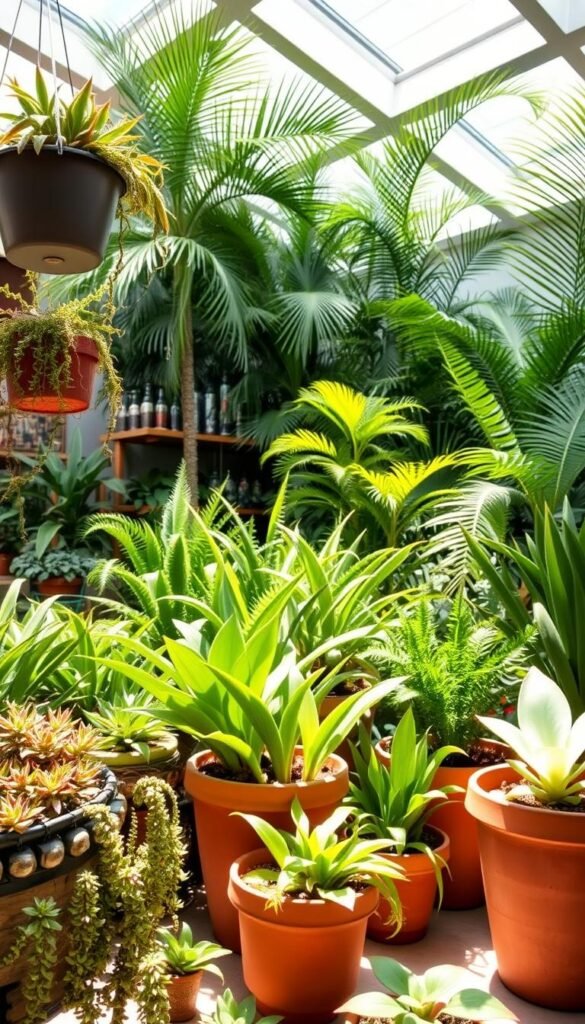
Not all greenery is created equal when it comes to your pet’s safety. Many common houseplants contain hidden dangers that can affect your furry friends. From irritating sap to microscopic crystals in leaves, these hazards often go unnoticed until curiosity strikes.
Ensuring Cat Safety With the Right Choices
Your feline’s nibbling habits demand careful plant selection. Some species contain calcium oxalate crystals—tiny shards that cause mouth swelling and stomach trouble. Spider plants and Boston ferns offer lush textures without risks, making them ideal for homes with prowling paws.
| Risky Plants | Safe Alternatives | Key Differences |
|---|---|---|
| Lilies | Areca palms | No pollen toxicity |
| Pothos | Parlor palms | Smooth-edged leaves |
| Dieffenbachia | Calathea | Non-irritating sap |
Avoiding Toxicity in Your Indoor Garden
Proactive choices prevent midnight vet visits. While some pets show mild symptoms, others face severe reactions to the same plant. Always cross-check new additions against ASPCA’s toxicity database. Your vet can recommend specific varieties based on your companion’s behavior.
Remember: What’s harmless to humans might distress animals. Cluster safer options in accessible areas and save delicate specimens for elevated displays. This balance lets everyone enjoy your green oasis worry-free.
Designing an Indoor Cat Garden: Creative Ideas and Layouts
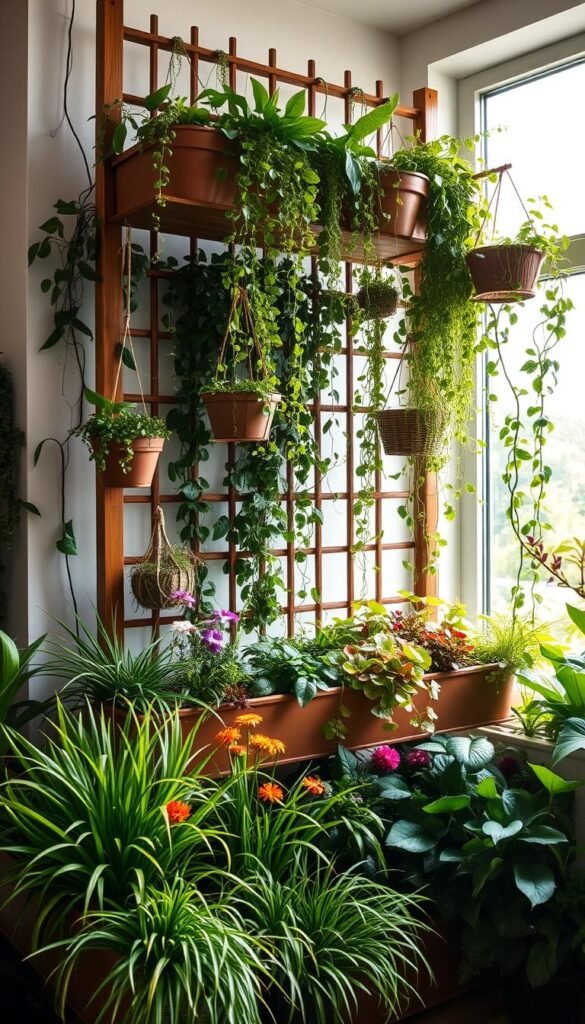
Elevating your greenery transforms blank walls into living art while protecting delicate leaves. Clever layouts blend climbing structures with foliage displays, turning vertical surfaces into shared playgrounds. This approach solves space challenges while letting you showcase your favorite species safely.
Vertical Spaces and Hanging Solutions
Wall-mounted systems let you display trailing vines like peperomia or string of hearts beyond jumping range. Sturdy brackets hold planters securely, creating cascading greenery that adds depth to rooms. Opt for lightweight materials like macramé or recycled plastic to simplify adjustments.
Furniture That Merges Play and Greenery
Modern cat towers now include built-in pots for spider plants or cat grass. These multi-level structures satisfy climbing instincts while keeping nibble-friendly options within paw’s reach. Position taller units near windows to give whiskered explorers sunny perches beside thriving foliage.
Shelving units with integrated planters offer another smart way to combine form and function. Alternate between trailing pothos and sturdy succulents for visual variety. Always secure heavy containers at the base to prevent tipping during enthusiastic play sessions.
Key Benefits of an Indoor Cat Garden for Your Home
Your living space becomes more than just four walls when greenery meets feline curiosity. Thoughtfully chosen foliage works double duty—enhancing your environment while keeping whiskered companions content. Let’s explore how this symbiotic relationship elevates daily life.
Improved Air Quality and Mood Boost
Spider plants act as natural air filters, quietly removing common toxins like formaldehyde from your rooms. Studies show certain houseplants can eliminate up to 87% of airborne pollutants within 24 hours. Breathe easier knowing your decor actively refreshes the atmosphere.
Greenery’s impact goes beyond physical health. Caring for living things creates a calming rhythm in your day. Watering sessions become mindful pauses, while new growth sparks quiet pride. One plant enthusiast shares: “Tending my collection feels like meditation with visible results.”
Winter dryness fades when leafy companions release moisture naturally. Your skin and sinuses will thank you for the added humidity. Meanwhile, vibrant leaves transform stark corners into inviting nooks that delight both eyes and paws.
This green partnership offers unexpected rewards. Watch your space evolve into a thriving ecosystem where every spray of water or unfurling leaf tells a story. You’ll nurture life while creating shared joy—one safe nibble at a time.
Indoor Cat Garden: Pet-Friendly Plants to Keep Kitties Happy and Safe
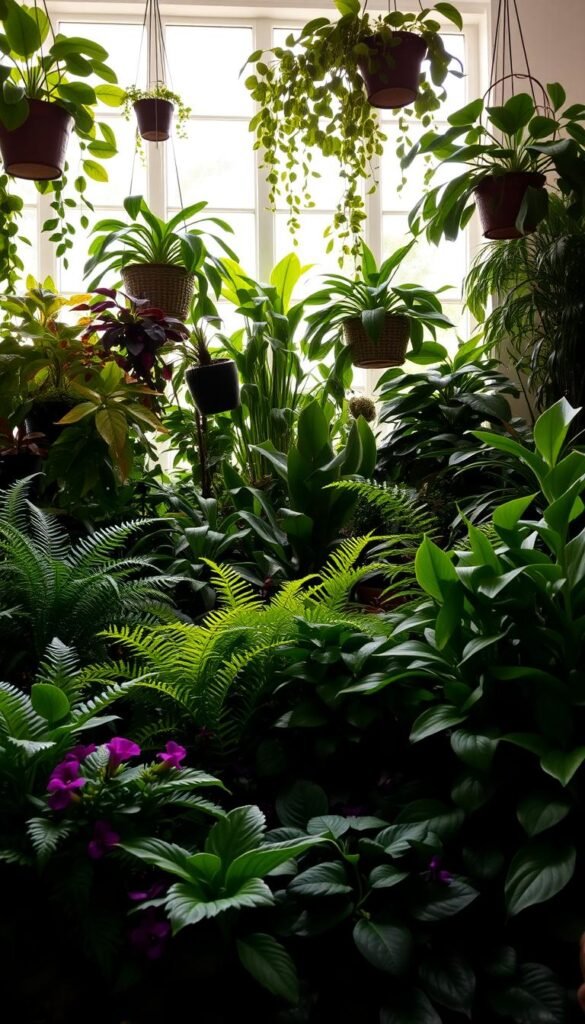
Transform your rooms with 28 veterinarian-approved options that merge beauty with safety. These carefully selected species offer lush textures and vibrant hues while eliminating health risks. Expert-backed choices mean every leaf and stem enhances your decor without hidden dangers.
Mix broad elephant ear calatheas with wispy ferns for striking contrasts. Velvety purple passion plants add pops of color beside trailing peperomia’s rounded leaves. This diversity creates eye-catching displays that withstand occasional paw swats or gentle nibbles.
Low-light lovers like zz plants flourish in dim corners, while sun-seeking succulents thrive on bright sills. Rotate specimens seasonally to match changing light conditions across your home. You’ll find perfect matches for north-facing bedrooms and south-facing lounges alike.
Stylish arrangements prove safety doesn’t limit creativity. Cluster polka dot plants with prayer varieties for dynamic patterns. Add height with mature ponytail palms—their flowing fronds entertain leaping companions while purifying air.
Your feline’s environment gains sensory richness through crinkly grasses and aromatic herbs. These living toys stimulate natural behaviors without toxic consequences. Many pet-safe varieties require less frequent watering than delicate orchids or fussy ficus trees.
With this curated palette, you craft spaces where greenery and whiskered explorers coexist beautifully. Every choice supports both your design vision and your companion’s well-being.
Understanding Plant Toxicity and How to Prevent Risks
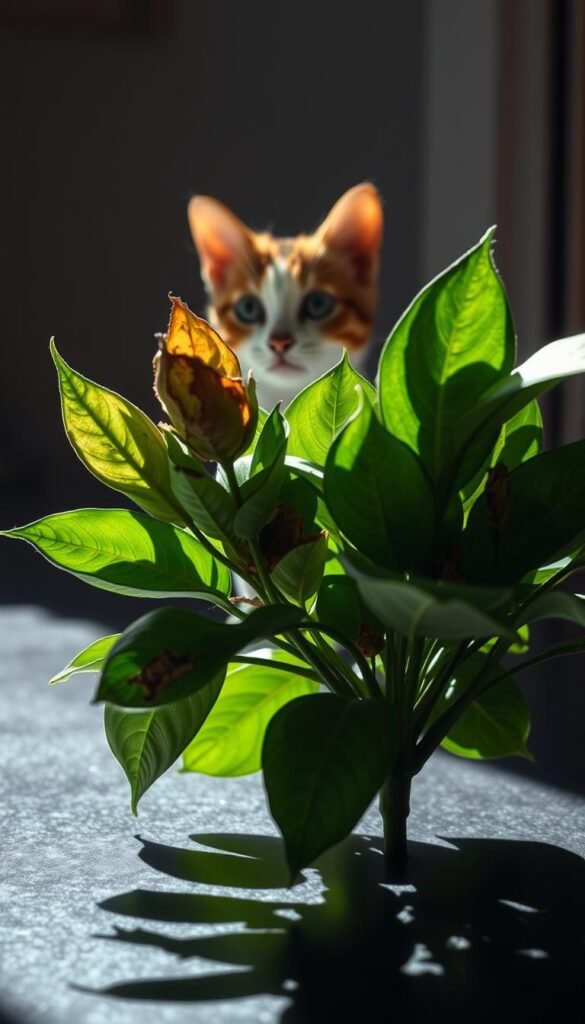
Your feline’s curiosity could turn dangerous faster than you expect. Common household greenery often hides invisible threats, with over 700 species posing risks to animals. Early symptom recognition separates minor incidents from life-threatening emergencies.
Recognizing Warning Signs in Your Cats
Watch for sudden behavior changes like excessive drooling or pawing at the mouth. Vomiting and lethargy often appear first, sometimes within two hours of exposure. Severe cases may involve tremors or labored breathing—these demand instant vet attention.
Lilies deserve special caution. A single nibbled leaf or pollen grain can trigger kidney failure. “Time becomes critical with lily toxicity,” warns Dr. Sarah Wooten. “Delayed treatment often leads to irreversible damage.”
Consulting with Your Vet for Tailored Advice
Gather plant samples or photos before calling your clinic. Vets need details like exposure time and quantity consumed. Keep the ASPCA Animal Poison Control Center number (888-426-4435) saved in your phone for after-hours crises.
Never induce vomiting without professional guidance—some toxins cause more harm coming back up. Your vet might recommend activated charcoal or IV fluids based on the specific plant involved.
“Bring the plant’s scientific name if possible—common labels like ‘lily’ cover multiple species with varying dangers.”
Caring for Your Indoor Cat Garden: Watering and Light Essentials
Mastering plant care starts with two simple elements—hydration and illumination. Your green companions thrive when these factors align with their natural rhythms. Whether you’re nurturing trailing vines or compact succulents, understanding their needs creates a flourishing environment.
Proper Watering Practices and Soil Moisture Tips
Stick your finger in the dirt—it’s the best moisture meter you own. Most varieties prefer hydration when the top two inches feel dry. Spider plants might need weekly drinks, while ZZ plants thrive on neglect, requiring water only every 3-4 weeks.
Drainage holes are non-negotiable. Pair them with chunky soil mixes containing perlite or orchid bark to prevent soggy roots. One plant enthusiast swears by this trick: “I water until it flows through the pot’s base, then wait until the soil whispers ‘thirsty’ again.”
Optimizing Light: Indirect, Low, and Bright Conditions
Bright indirect light fuels growth for 70% of pet-safe varieties. Place trailing pothos near east-facing windows where morning sun gently bathes their leaves. Low-light champions like snake plants adapt to dim corners, stretching toward ambient brightness.
Rotate pots weekly to prevent lopsided growth. Maintain temperatures between 60-80°F—most plants shudder below 55°F. Tropical varieties appreciate occasional misting, while succulents prefer arid air.
| Plant Type | Water Frequency | Light Preference |
|---|---|---|
| Spider Plant | Weekly | Bright indirect |
| ZZ Plant | Monthly | Low light |
| Parlor Palm | Bi-weekly | Medium indirect |
Pet-Safe Succulents, Spider Plants, and Air Purifiers
Spider plants bring life to your space without the worry. Veterinarians love them for their air-cleaning power and toughness. These leafy friends grow fast in bright spots away from direct sun. Their arching leaves stay vibrant in temps between 60-80°F.
Succulents like Haworthia add desert charm safely. They crave sunny windowsills and dry soil. Water them lightly every two weeks—only when the dirt feels parched. Their chunky leaves store moisture, making them perfect for forgetful waterers.
Balance your collection with both types. Spider plants handle regular drinks, while succulents thrive on neglect. One plant parent shares: “My spider plant survived three moves and a curious kitten—it’s practically family now.”
| Plant Type | Light Needs | Water Frequency | Soil Preference |
|---|---|---|---|
| Spider Plant | Bright indirect | Weekly | Moist, well-draining |
| Haworthia | Direct sunlight | Every 14 days | Dry, sandy mix |
These options keep noses and paws safe. Though spider plants might give cats a mild buzz, they’re non-toxic. Cluster them in hanging baskets to discourage snacking. You’ll enjoy clean air and worry-free greenery that fits busy lives.
Incorporating Colorful Flowering Plants into Your Garden
Your space deserves vibrant hues without compromising safety. Flowering varieties offer bursts of color while aligning with pet-conscious values. Strategic selections let you enjoy nature’s artistry worry-free.
Selecting Blooms That Brighten Safely
Orchids reign supreme for long-lasting elegance. Their delicate flowers thrive in partial light, needing weekly winter watering. Place them where morning sun filters through sheer curtains for optimal growth.
African Violets bring jewel-toned charm to shelves. The 2024 Houseplant of the Year flaunts purple and pink clusters. These compact beauties flourish under artificial or filtered natural light.
Celebrate seasons with Christmas Cactus. Its fiery red and white blossoms emerge as temperatures drop. This low-maintenance option handles occasional neglect, perfect for busy plant lovers.
Rotate flowering varieties to match your room’s light patterns. Pair cascading orchids with upright violets for dynamic displays. Always verify species names—some “cactus” types aren’t true succulents.
“My cat ignores the blooms but loves watching them sway,” shares one urban gardener. By choosing wisely, you create living rainbows that delight eyes without endangering paws.

